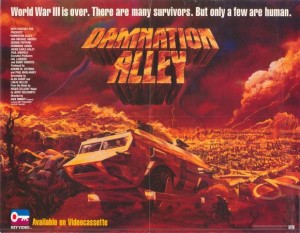1st Lieutenant Jake Tanner (Jan-Michael Vincent), an unorthodox Air Force officer, shares ICBM silo duty at an Air Force missile base in California with Major Eugene “Sam” Denton (George Peppard). When the United States detects incoming nuclear missiles, Tanner and Denton “turn the key” to launch part of the retaliatory strike, initiating Doomsday. After launching their entire arsenal of nuclear missiles, Tanner and Denton witness nuclear devastation rain down all around them.
Two years later, the Earth has been tilted off its axis by World War III, radiation has mutated insect life, and the planet is constantly wracked by massive storms that cover the entire hemisphere. Military order at the base has broken down. Tanner has resigned his commission and Denton is considering going to Albany, New York to find the source of a lone radio transmission. Before they abandon the base, a rocket fuel explosion kills all but four men — Denton, Tanner, former Airman Keegan (Paul Winfield) and Airman Tom Perry (Kip Niven).
They set out in two Air Force “Landmasters,” giant 12-wheeled armored personnel carriers capable of climbing 60-degree inclines and operating in water. They must cross “Damnation Alley,” considered “the path of least resistance” between intense radiation areas. On their journey, they lose one Landmaster in a storm (which also kills Perry), pick up two survivors, fight a band of crazed, savage shotgun-toting mountain men and encounter mutated “flesh stripping cockroaches” in the ruins of Salt Lake City, which eat Keegan alive, as well as a tidal wave set off by earth suddenly returning to its normal axis (admidst terrific energy storms in the night sky) before reaching their destination, a surprisingly intact Albany.
Roger Zelazny’s original story of Damnation Alley was seriously compromised in the final script. Zelazny was quite pleased with the first script by Lukas Heller and expected it to be the shooting script. However, the studio had Alan Sharp write a completely different version that left out most of the elements of Zelazny’s book. Zelazny did not realize this until he saw the movie in the theater. He hated the movie, but assertions that he requested to have his name removed from the credits are completely unfounded, since he did not know there was a problem until after the movie had been released.
Budgeted at $17,000,000 USD (a large budget at the time), “Damnation Alley” was helmed by veteran director Jack Smight, who had scored two consecutive box office hits in the previous two years (Airport 1975 and Midway) Filming began in July 1976 in the Imperial Valley in Southern California (near Glamis), as well as locations in Meteor Crater, Arizona, Salt Lake City, Utah, and the Mojave Desert in California.
Production was rife with problems – the devastated landscapes and giant mutated insects proved to be nearly impossible to create despite the large budget. For example, a sequence involving giant 8-foot-long (2.4 m) scorpions attacking a motorcycle was first attempted using full-scale scorpion props, but they did not work and the resulting footage was unacceptable. The solution was to use actual scorpions composited onto live action footage using the blue screen process in post production – unfortunately with poor results. Another action sequence with giant cockroaches used a combination of live Madagascar Hissing Cockroaches and large numbers of rubber bugs, which looked unconvincing onscreen as the strings pulling the fake insects were plainly visible.
The centerpiece of the film, the 12-wheeled, seven-ton “Landmaster”, performed much better than expected. The Landmaster was so convincing, in fact, that Fox demanded that more shots of the Landmaster appear in the film to make up for shortcomings. The decision was also made to add “radioactive skies” in post-production to add the visual excitement of a “post-Apocalyptic” world to the film.
Because of this last-minute decision, Damnation Alley was in post-production for over 10 months due to the difficult process of superimposing optical effects on the sky in eighty percent of the shots. It was during this period that 20th Century Fox released their “other” science fiction film for 1977. The studio had planned to release only two science fiction films that year, with Damnation Alley intended to be the blockbuster.
The other film — in which 20th Century Fox executives had very little confidence — was Star Wars.
Star Wars became a massive hit, and forced Fox to readdress Damnation Alley. In a panic, the release date was delayed further while Fox went in to re-edit the entire film. Directorial control was wrestled from Smight, and large sections of the film were edited out by the studio, including several key scenes critical to the storyline. The film was finally released on October 21, 1977 to poor reviews and tanked at the box office.
If you have some thoughts to share about this article or you’d
like to discuss B movies with other B movie fans and filmmakers please
visit our B Movie Nation Facebook group.


